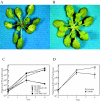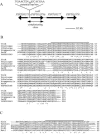Novel virulence gene of Pseudomonas syringae pv. tomato strain DC3000
- PMID: 16267304
- PMCID: PMC1280305
- DOI: 10.1128/JB.187.22.7805-7814.2005
Novel virulence gene of Pseudomonas syringae pv. tomato strain DC3000
Abstract
Previously, we conducted a mutant screen of Pseudomonas syringae pv. tomato strain DC3000 to identify genes that contribute to virulence on Arabidopsis thaliana plants. Here we describe the characterization of one mutant strain, DB4H2, which contains a single Tn5 insertion in PSPTO3576, an open reading frame that is predicted to encode a protein belonging to the TetR family of transcriptional regulators. We demonstrate that PSPTO3576 is necessary for virulence in DC3000 and designate the encoded protein TvrR (TetR-like virulence regulator). TvrR, like many other TetR-like transcriptional regulators, negatively regulates its own expression. Despite the presence of a putative HrpL binding site in the tvrR promoter region, tvrR is not regulated by HrpL, an alternative sigma factor that regulates the expression of many known DC3000 virulence genes. tvrR mutant strains grow comparably to wild-type DC3000 in culture and possess an intact type III secretion system. However, tvrR mutants do not cause disease symptoms on inoculated A. thaliana and tomato plants, and their growth within plant tissue is significantly impaired. We demonstrate that tvrR mutant strains are able to synthesize coronatine (COR), a phytotoxin required for virulence of DC3000 on A. thaliana. Given that tvrR mutant strains are not defective for type III secretion or COR production, tvrR appears to be a novel virulence factor required for a previously unexplored process that is necessary for pathogenesis.
Figures



Similar articles
-
CorR regulates multiple components of virulence in Pseudomonas syringae pv. tomato DC3000.Mol Plant Microbe Interact. 2006 Jul;19(7):768-79. doi: 10.1094/MPMI-19-0768. Mol Plant Microbe Interact. 2006. PMID: 16838789
-
PsrA, the Pseudomonas sigma regulator, controls regulators of epiphytic fitness, quorum-sensing signals, and plant interactions in Pseudomonas syringae pv. tomato strain DC3000.Appl Environ Microbiol. 2007 Jun;73(11):3684-94. doi: 10.1128/AEM.02445-06. Epub 2007 Mar 30. Appl Environ Microbiol. 2007. PMID: 17400767 Free PMC article.
-
Contribution of the non-effector members of the HrpL regulon, iaaL and matE, to the virulence of Pseudomonas syringae pv. tomato DC3000 in tomato plants.BMC Microbiol. 2015 Aug 19;15:165. doi: 10.1186/s12866-015-0503-8. BMC Microbiol. 2015. PMID: 26285820 Free PMC article.
-
Defining essential processes in plant pathogenesis with Pseudomonas syringae pv. tomato DC3000 disarmed polymutants and a subset of key type III effectors.Mol Plant Pathol. 2018 Jul;19(7):1779-1794. doi: 10.1111/mpp.12655. Epub 2018 Feb 1. Mol Plant Pathol. 2018. PMID: 29277959 Free PMC article. Review.
-
Pseudomonas syringae pv. tomato DC3000: a model pathogen for probing disease susceptibility and hormone signaling in plants.Annu Rev Phytopathol. 2013;51:473-98. doi: 10.1146/annurev-phyto-082712-102321. Epub 2013 May 31. Annu Rev Phytopathol. 2013. PMID: 23725467 Review.
Cited by
-
Mqo, a tricarboxylic acid cycle enzyme, is required for virulence of Pseudomonas syringae pv. tomato strain DC3000 on Arabidopsis thaliana.J Bacteriol. 2009 May;191(9):3132-41. doi: 10.1128/JB.01570-08. Epub 2009 Feb 27. J Bacteriol. 2009. PMID: 19251849 Free PMC article.
-
How Does the Sweet Violet (Viola odorata L.) Fight Pathogens and Pests - Cyclotides as a Comprehensive Plant Host Defense System.Front Plant Sci. 2018 Sep 11;9:1296. doi: 10.3389/fpls.2018.01296. eCollection 2018. Front Plant Sci. 2018. PMID: 30254654 Free PMC article.
-
A high-throughput forward genetic screen identifies genes required for virulence of Pseudomonas syringae pv. maculicola ES4326 on Arabidopsis.PLoS One. 2012;7(8):e41461. doi: 10.1371/journal.pone.0041461. Epub 2012 Aug 1. PLoS One. 2012. PMID: 22870224 Free PMC article.
-
Global analysis of the HrpL regulon in the plant pathogen Pseudomonas syringae pv. tomato DC3000 reveals new regulon members with diverse functions.PLoS One. 2014 Aug 29;9(8):e106115. doi: 10.1371/journal.pone.0106115. eCollection 2014. PLoS One. 2014. PMID: 25170934 Free PMC article.
-
Spatiotemporal Monitoring of Pseudomonas syringae Effectors via Type III Secretion Using Split Fluorescent Protein Fragments.Plant Cell. 2017 Jul;29(7):1571-1584. doi: 10.1105/tpc.17.00047. Epub 2017 Jun 14. Plant Cell. 2017. PMID: 28619883 Free PMC article.
References
-
- Blanco, C., M. Mata-Gilsinger, and P. Ritzenthaler. 1985. The use of gene fusions to study the expression of uidR, a negative regulatory gene of Escherichia coli K-12. Gene 36:159-167. - PubMed
-
- Boch, J., V. Joardar, L. Gao, T. L. Robertson, M. Lim, and B. N. Kunkel. 2002. Identification of Pseudomonas syringae pv. tomato genes induced during infection of Arabidopsis thaliana. Mol. Microbiol. 44:73-88. - PubMed
MeSH terms
Substances
LinkOut - more resources
Full Text Sources
Molecular Biology Databases

